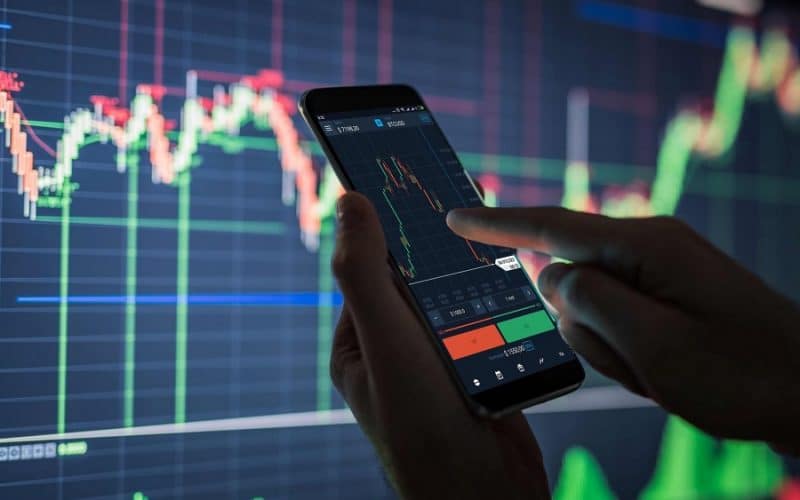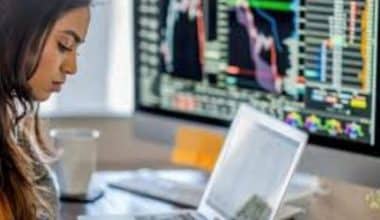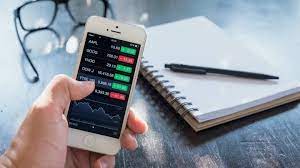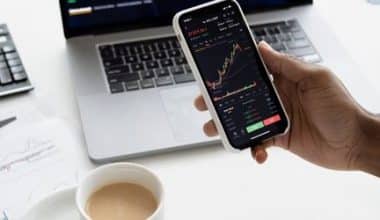Despite the widespread availability of smartphones, not all trading apps provide the same features. This 2023 trading guide discusses the best trading apps available from various firms. The foreign exchange market (Forex) is a lucrative opportunity for traders around the world. Conquering this market, however, is no simple task, as traders need to be aware of all the newest happenings in the financial sector. The emergence of trading apps and the widespread adoption of mobile devices have made this simpler in recent years. In this article, we will discuss the best stocks, cryptocurrency, and Day trading apps traders should consider.
What Are Trading Apps?
Trading apps are a type of online trading system that uses trading software to facilitate transactions over a network. Depending on the broker, trading apps can be used for free or at a reduced rate.
Traders and investors can manage their money and make deals in the securities market with the help of trading apps. Databases with complex architecture are used by the most effective trading apps to improve safety, increase the visibility of data, and supply secondary market liquidity.
Furthermore, traders are able to engage in a satisfactory manner, apply relevant search criteria, and electronically negotiate offers based on transaction parameters and other terms and conditions in a network-based setting that satisfies the needs of all parties involved.
The Basics of Trading Apps
Financial organizations like banks and brokerages provide investors and traders with trading apps, which is a software system. Traders and investors can make transactions and keep tabs on their accounts with the help of trading platforms.
Often, trading apps typically provide a plethora of additional tools to aid traders in making informed trades. Some examples of such options are streaming news feeds, paid research, and a variety of charting tools. Stock, currency, option, and futures markets are just some examples of markets that can have their own dedicated platforms.
Commercial systems and proprietary systems are the two categories of trading apps. Commercial systems cater to retail investors and day traders. They are distinguished by their user-friendliness and a wide range of useful functions, such as up-to-the-minute quotes, worldwide news feeds, live, interactive charts, instructional materials, and research tools.
However, huge brokerages and other financial organizations often construct their own proprietary platforms, which they use exclusively for their own trading purposes. The general population cannot purchase these.
Types of Trading Apps
There are two distinct categories of trading apps: proprietary (or “prop”) and public (or “commercial”). Large brokerage firms create the applications used by prop trading platforms, and these programs are modeled after the trading habits and requirements of electronic brokerage platforms.
On the other hand, retail investors and day traders are the primary customers of commercial trading apps. Easy to navigate and packed with useful tools like charts and news feeds, commercial trading apps provide investors and traders with more in-depth data and insights.
For active trading, a wide variety of trading tools and approaches that can help identify trends are necessary. Experience with actual trading is essential for deciding on the best trading tool.
What to Look Out for in Trading Apps
When choosing a trading app here are things to look out for as a trader.
#1. Features
Traders and investors should evaluate the capabilities of trading apps to see if they satisfy their requirements. Features like Level 2 quotations and access to market depth data like price levels, order size, and volume can be very useful for day traders and other short-term traders who need to time their orders precisely.
Also, live charts with a variety of technical indicators are examples of technical analysis tools that could be useful. When trading options, it might be helpful to have access to resources that are specific to your needs for information gathering, analysis, and backtesting.
#2. Fees
When selecting a trading app, fees are another factor that should not be overlooked. Traders who utilize the method of “scalping,” for instance, will naturally go toward apps that have the lowest fees. In principle, it is usually desirable to have cheaper fees, but there may be trade-offs that need to be considered. For instance, cheap costs would not be beneficial if they are accompanied by a decrease in the number of features or their overall power.
#3. Provider
There are several trading apps that are not connected to any particular broker or intermediary. On the other hand, you can only access certain trading platforms if you collaborate with a specific broker or intermediary. Therefore, before committing to a particular trading app to execute trades and manage their accounts, investors should give serious consideration to the reputation of the middleman or broker who will be handling their transactions. Ensure that a supplier fully supports all of the features that an app has to offer.
#4. Requirements
Last but not least, trading apps may have particular prerequisites that must be satisfied before an account can be opened and/or trading can begin. For example, in order for traders to be approved for margin trading on day trading platforms, the platforms may mandate that the traders have a minimum of $25,000 in equity in their accounts. Before being allowed to utilize the trading app, traders on options platforms might need to first demonstrate that they are authorized to deal in a variety of different types of options.
Examples of Popular Trading Apps
Here are some of the best trading apps traders might want to consider.
- Robinhood. Robinhood appeals to young adults by providing them with a trading platform that is free of charge. The transformation of the trading platform from a mobile application to a network-based platform represents a recent industry trend. Its revenue comes from a variety of sources, including revenues from order flow to major intermediaries and interest on consumer account balances.
- Interactive Brokers. Interactive Brokers is a trading platform that is centered on investors’ interests and is designed for investors who have a professional understanding of investing. It gives investors access to markets all over the world at a relatively modest cost.
- TD Ameritrade. TD Ameritrade, which is one of the most well-known trading platforms, gives investors and traders access to its brokerage services. After acquiring ThinkoSwim, the platform went on to construct what is now known as the Trade Architect platform.
- TradeStation. Trading algorithms also use TradeStation, which is another major trading platform. It uses scripts written in Easy-Language to automatically place trades.
In addition, MetaTrader, a trading tool that connects to numerous brokers, is the most widely used application in the foreign exchange (forex) industry. Its MQL scripting language has gained widespread use among individuals who wish to automate currency trading.
How Can I Start Trading?
Trading is the practice of purchasing and selling assets, most commonly shares in a firm, within a period of time that is considered to be relatively brief. Traders go into each transaction with the expectation of turning a profit, with the possibility of realizing big profits over the course of a series of deals.
According to investment business GraniteShares, day trading had a boom during the epidemic, with roughly two million people in the UK engaging in trading for the very first time. The bulk of these traders were driven to participate in the market by the prospect of earning returns on their investments that were superior to those that could be obtained from placing cash in savings accounts that paid interest. Here are ways to start trading.
- Learn the basics of how trading works.
- Take a look at some examples of transactions.
- Do some research on the various marketplaces.
- Learn the hazards involved in trading and the strategies you can use to mitigate them.
- Gain a deeper understanding of the various trading styles and tactics.
- Develop a strategy for trading.
- You should start out by trading on a practice account.
- Start trading by establishing a real account for yourself.
Stocks Trading Apps
Put in a lunchtime order. Making a payment on a bill. Logging your steps each day. These and other uses of smartphones have become commonplace, and now too are stock trading and investment.
Having a functional smartphone app is now considered a prerequisite for success among U.S. online stockbrokers, including both established players like Fidelity and Charles Schwab and upstarts like Robinhood and Webull. In this saturated market, the best stock trading apps are the ones that cater to your individual requirements and tastes.
Furthermore, the best stock trading apps should shine in all respects, from their usability to their design to the depth of their online trading tools to the low or no commissions they charge on stock and ETF trades. Also, read Stock Trading Business: How to Start a Stock Trading Business.
Overview of the Best Stocks Trading Apps
Here are some of the best stocks trading apps investors might want to consider,
#1. TD Ameritrade
In 2023, TD Ameritrade’s two robust mobile apps for iOS and Android smartphones made it one of the most competitive stock trading apps available. The suite comprises the TD Ameritrade Mobile app, which is a mobile version of the company’s client online portal, and the robust thinkorswim app, which offers features and advanced charts similar to those available on the website and desktop versions.
Features including news, price alerts, watch list syncing, and basic charts, as well as ratings and research reports from third-party providers, make TD Ameritrade Mobile a fantastic app for casual investors.
When it comes to technical analysis, the fact that the thinkorswim mobile app has some of the most robust charting packages available via mobile (with over 400 indicators) is crucial. Smart design and layout also simplify the process of preparing multiple order types. CNBC’s uninterrupted programming throughout the trading week means that traders can access its news headlines and TV feeds on the TD Ameritrade Network.
#2. Interactive Brokers
Interactive Brokers Trader Workstation, a desktop trading platform, consistently ranks as one of the best in the industry. It provides three distinct apps: the all-encompassing IBKR; the GlobalTrader app for novice international stock traders; and the Impact app for ESG (environmental, social, and governance) investment.
Though it’s not ideal for newbies, IBKR Mobile has every tool and function an investor might want. The app’s strong points include real-time data streaming, comprehensive order entry, portfolio management, and advanced charting with 70 customizable indicators. A peculiar shortcoming is that stock updates are sent via email rather than push notifications.
If you are an investor interested in screening your stock portfolio for social and environmental issues, Interactive Brokers has one of the best stock trading apps available. Focusing on ESG (environmental, social, and governance) investing, it has developed the Impact app. Users select values important to them, such as access to clean water, and then name business activities (like animal testing or carbon emissions) that run counter to those values. The application finds businesses that align with the user’s ethics, and they may “swap” portfolio holdings with a single transaction.
Although still in beta, GlobalTrader’s ease of use is a joy to experience. It’s as simple to use as Robinhood, a game-changer in the market, but it gives you access to Interactive Brokers’ extensive tools as your interest in and expertise with investing develop. In addition, Access 90 markets from around the world and trade in fractional shares or cryptocurrencies with GlobalTrader.
#3. E*TRADE
E*TRADE’s collection of mobile apps for iOS and Android smartphones is highly regarded. The E*TRADE suite includes the user-friendly E*TRADE Mobile app for regular investing, as well as the robust Power E*TRADE software for active trading.
There is a surprising amount of depth and diversity of tools available in the mobile version of E*TRADE, making it suitable for both novice and experienced traders. There are high-level study reports available, and each chart features 10 indicators. The app’s design makes exploring and learning about its capabilities a breeze.
In contrast, Power E*TRADE is the greatest trading app for frequent traders. More than a hundred different charting indicators and complicated trade orders are available. Even though it’s an efficient trading app with advanced features for serious traders, the app’s sleek design and intuitive layout make it a breeze to use.
#4. Fidelity
Fidelity, our pick for Best Overall Broker in 2023, has a number of mobile apps available for both Android and iOS devices, but its stock trading app is where most investors and traders will spend their time. Fidelity’s trading app is great for everyday investors, whether you’re banking, transferring money between accounts, handling orders, or conducting trades, while beginners will like Bloom and Spire.
In keeping with Fidelity’s Active Trader Pro desktop platform, the app includes streaming TV from Bloomberg in addition to a tailored feed, news headlines, and research. ConsThe app isn’t great for day traders or those who are pickier about their charts. However, the design is great, and new, cutting-edge features are being introduced all the time. If you want something a little less complicated, you can always switch to the Beta Experience.
CryptoCurrency Trading Apps
Cryptocurrency trading is seen by many as a potential source of passive income. Some people see it as an alternative to more conventional investment strategies. Due to Bitcoin’s meteoric rise to over $63,000 in April 2021, the number of speculative crypto traders increases every day.
While most investors use mobile apps, crypto traders often prefer desktop platforms. Individuals, small groups, and large organizations can all participate in cryptocurrency trading. This is a professional venture that should be considered.
The top cryptocurrency apps let users make instantaneous, low-fee deposits of fiat currency, accept a wide variety of fiat deposit methods, charge no or low costs for trading cryptocurrencies, and charge no or low fees for withdrawing cryptocurrency. The best cryptocurrency trading apps or exchanges also have institutional-grade custody integration, as well as mining and staking capabilities.
Traders may increase their profits with the use of high-quality apps that provide real-time price tracking, real-time notifications, and complex charting.
How to Trade Cryptocurrencies
Here are simple steps on how to trade cryptocurrencies.
- Investigation of Financial Apps – Features such as accepting fiat and cryptocurrency deposits, fast deposits, P2P trading, fees, and commissions, order books, credit card and other payment method support, and verification processes can vary widely between apps. Join the network whose virtual currency wallet best suits your needs, then set one up.
- Money can be deposited via bank transfer, credit card, VISA, WebMoney, etc. Make sure your preferred method of adding money to the app is supported. The most reliable cryptocurrency purchase apps support quick deposits. A few of them happen instantly, while others take days.
- You can place orders with various cryptocurrency apps that facilitate P2P trading. Find a trading partner and either accept their market orders or put in orders for them to accept as your market maker. To further minimize transaction costs, the best cryptocurrency trading software should also support maker orders.
- You can make purchases using a centralized order book with other crypto trading apps. Select the cryptocurrency you wish to purchase and enter the desired purchase amount before clicking the “buy” button. On cryptocurrency exchanges, traders can place a variety of orders, such as instant market, limit, stop loss, maker only, immediate or cancel, reduce only, and edit.
- Your cryptocurrency wallet will subsequently be credited. The wallet can be used for storing, gambling, or sending funds to others. The best Bitcoin trading app, as previously mentioned, also supports fiat currency investments.
Overview Best Cryptocurrency Trading Apps
Here are the best cryptocurrency trading apps you can consider as a crypto trader.
#1. Uphold
Uphold is a cryptocurrency trading app available for both iOS and Android that simplifies the process of buying and selling over 200 different digital currencies. It is now accessible in more than 150 countries around the world. You can have the best of both worlds, traditional assets like currencies, commodities, and stocks, and the more volatile but potentially lucrative cryptocurrency market.
The trading platform’s unique selling point is the ease with which users can switch between different assets. Additionally, there are no fees associated with making a deposit, and trading fees are levied as spreads of less than 2%. Spreads are tighter for more liquid cryptocurrencies.
Features.
- Short-notice market orders. Accepts limit orders.
- You can use your debit or credit card along with your bank account to make fast purchases with no additional fees from Uphold.
- Products for individuals, businesses, and developers/affiliates, with custodial and API trading tools for the latter.
- Officially documented by FinCEN, FCA, and the Bank of Lithuania.
- Staking
- Trading robots.
#2. ZenGo
You may trade over 70 different cryptocurrencies on ZenGo, including Bitcoin and Ethereum. It’s compatible with both Android and iOS, and its straightforward interface is what sets it apart from similar cryptocurrency trading apps.
MPC technology eliminates the need to copy, write down, and store the private key outside the wallet. To begin, that procedure is necessary when creating a standard, non-custodial wallet so that, no matter what happens to your phone or wallet, you can always restore it using the private key and access your cryptocurrency. Without it, the saved crypto would be useless.
With ZenGo, the private key is automatically stored on your mobile device, and in the event of a failure, you are guaranteed a full recovery. It’s encrypted, and the app can only be opened with a biometric password. The private key is divided into two separate secret shares by MPC technology. Your mobile device and the ZenGo server will each store one copy of your shares.
Your biometric face scan unlocks the secret share on your cloud service, such as Dropbox, which includes the decryption key. You can scan your face to access your cryptocurrency wallet even if you lose your phone or the ZenGo app. When the need arises, the device and server will work together to deliver funds and restore the wallet.
Features.
- Immediately trade crypto for fiat.
- You can purchase cryptocurrency with a credit card, debit card, bank wire, Apple Pay, Google Pay, MoonPay, Banxa, or any other suitable payment method. Minimums apply to each of these.
- Hold cryptocurrency for long-term passive income. You can also use other crypto staking and lending dApps (which can be linked to ZenGo using the WalletConnect bridge) to stake and lend cryptocurrency.
#3. Bybit
Bybit is a highly intelligent and user-friendly Bitcoin trading platform. It offers competitive market depth and liquidity in addition to real-time market data. It safeguards your possessions by putting them in an off-the-grid vault. Bybit has the ability to offer 24/7 multilingual help. The Bybit mobile app is compatible with both iOS and Android.
Features.
- Bybit’s spot trading solution gives users access to the market’s highest liquidity and best exchange rate for buying and selling cryptocurrencies in real-time.
- Traders of all skill levels can benefit from using the platform.
- In order to give users the greatest possible trading experience, the platform is regularly updated with new assets and cutting-edge goods.
- There are 59 different fiat currencies it can handle.
- The system allows for a wide variety of payment options, including major credit cards like Visa and Mastercard, debit cards, and even cash deposits.
#4. OKX
OKX is a cryptocurrency trading app that can be used on the web as well as Android and iOS mobile devices. The program can be used for both speculative buying and selling of cryptocurrencies on the spot markets, as well as for immediate purchases using a number of payment methods like credit cards. The latter enables investors to speculate on the direction of cryptocurrency prices with the use of sophisticated trading tools like charts and to take advantage of price fluctuations with bespoke order types.
Crypto options and futures trading are also made possible.
Over 300 crypto coins are available for trading on OKX, which also has robust liquidity books. In addition to staking, lending, NFTs, and mining, users can invest their funds in a variety of additional items.
Features.
- Use your bank card to buy cryptocurrency instantly.
- Protocol interfaces for cryptocurrency trading.
- The activity monitor.
- Use analytical tools and charts to aid in trading.
- Buying and selling in advance.
- Account storage and restore.
Benefits of Using Trading Apps
Here are some of the benefits of using trading apps.
- Take charge of market share. Trading apps are used by both experienced financial experts and novice traders to make transactions. A trading platform allows investors to open and exit positions in various marketplaces and manage their holdings.
- Examine Prospective Financial Investments. Trading apps allow investors to investigate a variety of financial instruments. Depending on the trading platform, you can use a variety of research tools, including historical data, analyst ratings, scenario analysis, and more.
- Examine the market’s behavior. Trade volume, order price, and market trend data are just a few examples of the types of market activity information that traders can expect to find on trading platforms. Understanding the overall trend of a market is just as important as knowing how a single asset will perform over a certain time frame. The best trading apps will equip their customers with everything they need to perform both.
Day Trading Apps
Day trading is a form of stock trading in which buyers and sellers of securities engage in transactions over the course of a single trading day. Also, day traders are unconcerned with the general direction of the market as a whole. A day trader can generate profits as long as there is volatility in the stock market by purchasing assets at lower prices and then selling them when their value increases. This strategy is known as “buy low, sell high.” Also, read HOW TO DAY TRADE: Complete Guide to Day Trading for Beginners.
Here are some of the best `day trading apps.
#1. Robinhood
Robinhood is an app for stock day trading that eliminates the need for a broker’s commission. Also, it is an online brokerage that allows its users to trade stocks with no commissions and no minimum investment.
When compared to other brokers, Robinhood eliminates most of the extras, but its free market cannot be beaten. The mobile-native framework of the app ensures that users’ stock purchases and sales carry over seamlessly from desktop to mobile device. Even better, new members can earn a free stake in a significant corporation, the specific share of which is determined by chance.
While experienced stock traders may be turned off by Robinhood’s lack of resources and research capabilities, rookie traders concerned about costs and commissions may appreciate the app’s design and straightforward interface.
#2. Magnifi
Magnifi is an app that facilitates optimal portfolio management through the use of standard brokerage tools and artificial intelligence. When you have access to comprehensive data on any specific asset, you can confidently put your money where it will produce the best returns and best fit your investment strategy.
Also, you can look for specific types of investments, scan for assets in a certain price range, or search for all investments.
The tool is ideal for long-term investors and those in need of client support, as it provides access to educational resources, an AI-powered investing assistant, commission-free trading, a mobile app, and over 15,000 different investment opportunities. Because of this, merchants of all skill levels will find Magnifi to be a welcoming environment.
#3. Moomoo
Moomoo is one of the best free day trading apps that works on iOS, Android, and Windows Mobile devices. One of the best alternatives to Robinhood is Moomoo. If you’re serious about smart trading, this trading platform is where it’s at.
Advanced charting, pre- and post-market trading, international trading, research and analysis tools, and, perhaps most importantly, free Level 2 quotations are just a few of the trading tools and opportunities offered by this platform.
Download Moomoo to your phone, tablet, or other mobile device right away to get started.
Bottom Line
It is not a simple task to choose the best trading application in the world because there are so many options available on the market. There is a wide variety of helpful functionality built into each of the currency trading apps that have been covered in this article for traders. However, the functionality that is successful for you might not be successful for another trader.
Frequently Asked Question
How much money do I need to start trading?
Some brokers do really accept a $100 first deposit. However, for a novice trader, it’s actually a good thing if you can’t open many deals of substantial magnitude. If you want to practice trading without risking any real money, you can open a “demo” account first.
Can trading make a lot of money?
Yes. Trading stocks or selling them when they are at their highest price point can also yield substantial rewards, but only if you take the time to track your portfolio in real-time and act accordingly.
Similar Article
- TRADE FINANCING: Definition, How It Works & Importance
- TRADE MARKETING: The Best Trading Strategies
- HOW TO BECOME A DAY TRADER: Step-by-Step Guide






